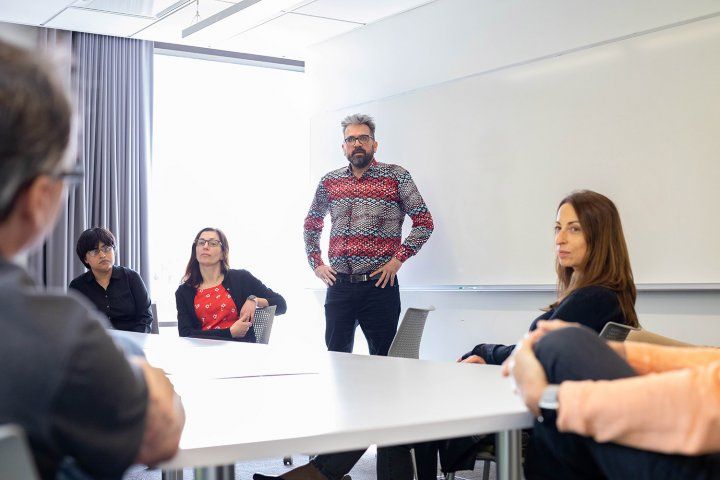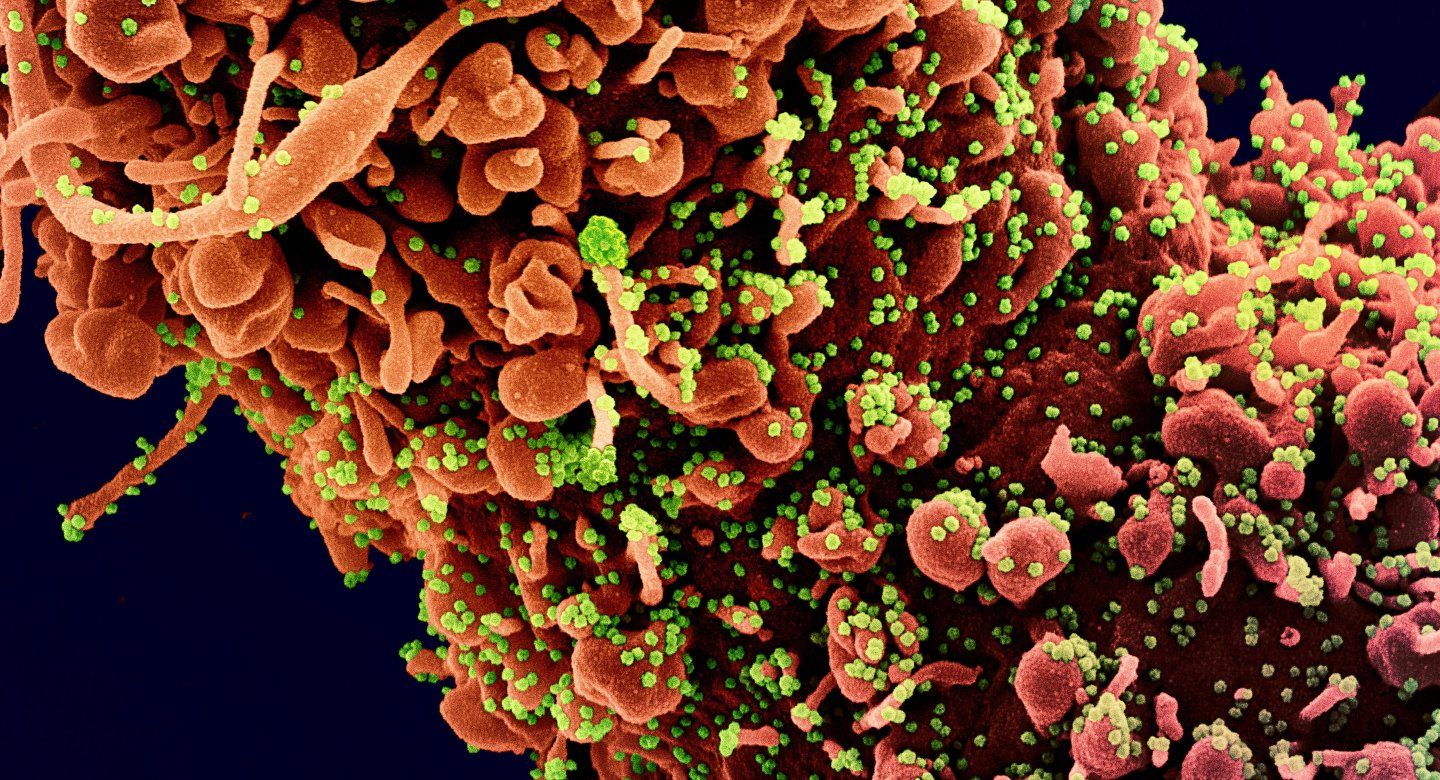Nature Publication Presents New ‘Blueprint’ Revealing How SARS-CoV-2 Virus Hijacks Human Cells
Points to Drugs with Potential to Fight COVID-19, and a Drug that Promotes Infection
An international team of more than 120 scientists has detailed the impact of 75 over-the-counter prescription and development-stage drug compounds on SARS-CoV-2, the virus that causes COVID-19. Several of these agents show promise in blocking SARS-CoV-2 replication in laboratory experiments. One compound investigated in the research, a common ingredient in over-the-counter cough medicines, appears to have the potential to promote the growth of the virus.
The collaborative study, published in Nature on April 30, 2020, was assembled and led by Nevan Krogan, PhD, director of the Quantitative Biosciences Institute at UC San Francisco and a senior investigator at Gladstone Institutes. As the first hints of the pandemic emerged in January, over a matter of just a few weeks, Krogan formed a rapid-response research team of dozens of scientists and clinicians – hailing from UCSF, Gladstone, Icahn School of Medicine at Mount Sinai in New York, and Institut Pasteur in Paris – to search for potential treatments for COVID-19.

Nevan Krogan (center), PhD, and his collaboration of scientists around the world have fast-tracked efforts to find the proteins in cells that get highjacked by COVID-19. Photo by Susan Merrell
Rather than focusing on an antiviral approach to block SARS-CoV-2, the researchers first combined biological and computational techniques to create a “blueprint” of more than 300 human proteins that the virus requires to infect human cells and to thrive and replicate in the body. They then explored the question of which drugs, both those that are currently marketed as well as those in development, might be repurposed to treat SARS-CoV-2 infection by targeting those human proteins.
The researchers emphasize that, while the drugs identified in the study are promising, they have only been tested against the virus in laboratory experiments. The researchers do not advocate anyone prescribing and/or using the drugs unless human clinical trials find them to be safe and effective.
Repurposed Compounds Show Promise for Fighting COVID-19; Further Research Needed
Looking at a list of drugs that interact with the protein blueprint, UCSF researchers Brian Shoichet, PhD, professor of pharmaceutical chemistry, and Kevan Shokat, PhD, professor of cellular and molecular pharmacology and a Howard Hughes Medical Institute investigator, led studies employing chemical biology and computational approaches. Two drug categories emerged as promising agents to effectively reduce viral infectivity: protein translation inhibitors (including zotatifin and ternatin-4), and drugs that modulate proteins inside the cell known as Sigma1 and Sigma2 receptors (including progesterone, PB28, PD-144418, hydroxychloroquine; the antipsychotic drugs haloperidol and cloperazine; siramesine, an antidepressant and anti-anxiety drug; and the antihistamines clemastine and cloperastine).
Among the protein translation inhibitors, the strongest antiviral effect in vitro was seen with zotatifin, which is currently in clinical trials for cancer, and ternatin-4, which was discovered and developed in the UCSF laboratory of Jack Taunton, PhD, professor of cellular and molecular pharmacology.
Among the Sigma1 and Sigma2 modulators, the antipsychotic haloperidol, used to treat schizophrenia, showed antiviral activity against SARS-CoV-2. Olanzapine, used to treat both schizophrenia and bipolar disorder, had no measurable effect on the virus. Two potent antihistamines, clemastine and cloperastine, displayed antiviral activity, as did PB28 and to a lesser extent the female hormone progesterone.
“While a large amount of COVID-19 therapeutic development research focuses on the antivirals and vaccines, we’ve taken a different approach, targeting the human counterparts and vulnerabilities required for viral infection in a human cell,” said Krogan. “Our work leverages approved and development-stage molecules and will help to focus clinical trials toward the most promising agents to combat COVID-19. We also continue to search for additional agents that target the human proteins used by SARS-CoV-2 to expand the armamentarium against the virus,” he said.
“While these are early data, we have a high degree of confidence in the results, since similar observations on the antiviral activity of these drugs arose from work done independently at both Mount Sinai and Institut Pasteur. Research at this speed and magnitude could only have been accomplished through a collaborative effort from several scientists at multiple institutions, each bringing unique but complementary skill sets towards a common research goal,” said Adolfo García-Sastre, PhD, professor in the Department of Microbiology and director of the Global Health and Emerging Pathogens Institute of the Icahn School of Medicine at Mount Sinai.
García-Sastre led the virological studies along with Marco Vignuzzi, PhD, principal investigator in the Viral Populations Unit at Institut Pasteur in Paris. Vignuzzi commented, “This study provides novel potential antiviral strategies that need to be explored, and it is unique in that it extends our knowledge on our basic understanding of how the virus interacts with the host.”
PB28 Shows Significantly Greater Antiviral Activity than Hydroxychloroquine
Among drugs targeting Sigma1 and Sigma2 receptors, a preclinical compound called PB28 had approximately 20 times greater antiviral activity in laboratory experiments than hydroxychloroquine, which is being studied as a potential therapy for COVID-19 in multiple clinical trials.
Theory for Cardiac Side Effects of Hydroxychloroquine
The new study presents a possible explanation for the serious cardiac side effects observed in some halted clinical studies of hydroxychloroquine. The researchers showed that, in addition to targeting the Sigma1 and -2 receptors, hydroxychloroquine also binds to a protein known as hERG, which is critical for regulating electrical activity in the heart. These laboratory findings may help explain the possible risks associated with this agent as a potential therapy for COVID-19.
Caution Urged for Dextromethorphan
Finally, the cough suppressant dextromethorphan, which acts on Sigma1 receptors, promoted viral infection in the laboratory experiments, and the researchers said that its use merits caution and warrants further study in the context of COVID-19.
Next Step: Testing Compounds in Animal and Human Clinical Studies for COVID-19
Krogan said the next step is to further investigate the most promising compounds to advance them as quickly as possible through clinical trials. “We are working with several pharma and biotech companies to evaluate the antiviral effectiveness and safety of drug candidates that showed the most promise in our laboratory experiments,” he said. “Conversely, because our research shows that dextromethorphan promotes SARS-CoV-2 infection in the laboratory, we urge that this compound be used prudently during the pandemic.”
Shokat added, “Our collaborative efforts have successfully mapped the proteins in the human body associated with SARS-CoV-2 infection, which has informed swift, science-based drug discovery. Uncovering the proteins targeted by this coronavirus has unveiled compounds across different drug classes that might have otherwise not have been obvious to study in a viral setting.”
Background on Innovative Scientific Approach
The researchers introduced the coronavirus proteins into human cells in culture. Once inside the cells, the viral proteins found specific human proteins that they could latch onto – very much as they would during a normal infection.
After identifying these proteins and determining small molecules known to bind them based on prior scientific research, the scientists identified 69 molecules that seemed most promising based on their targeting specificity.
Subsequently, the team assessed the impact of 47 of these compounds in cells infected with live virus, as well as an additional 28 compounds known to act on two key targets identified by other methods. These experiments were required to quickly establish robust and quantitative viral replication inhibition assays under high biocontainment to study the impact of these compounds on the biological cycle of the SARS-CoV-2 virus.
Aside from helping scientists quickly identify the most promising drug candidates to pursue, which may result in the initiation of new clinical trials, these results also provide broad insights into SARS-CoV-2 infection. Scientists can use this information to understand or anticipate the effect of experimental treatments already attempted in the clinic. Additionally, this novel approach for drug discovery can be leveraged across other viral and nonviral diseases.
Authorship and funding: This work was funded by grants from the National Institutes of Health, the National Institute of Mental Health, the Defense Advanced Research Projects Agency, the Center for Research for Influenza Pathogenesis, the Centers of Excellence for Influenza Research and Surveillance of the National Institute of Allergy and Infectious Diseases, the Centers of Excellence for Integrative Biology of Emerging Infectious Diseases of the Agence Nationale de la Recherche (France), F. Hoffmann-LaRoche AG, Vir Biotechnology, and the Ron Conway Family. Shokat is a Howard Hughes Medical Institute investigator. A complete list of authors and full funding information is available in the Nature paper.
About UCSF: The University of California, San Francisco (UCSF) is exclusively focused on the health sciences and is dedicated to promoting health worldwide through advanced biomedical research, graduate-level education in the life sciences and health professions, and excellence in patient care. UCSF Health, which serves as UCSF’s primary academic medical center, includes top-ranked specialty hospitals and other clinical programs, and has affiliations throughout the Bay Area.
About QBI: The Quantitative Biosciences Institute (QBI) fosters collaborations across the biomedical and the physical sciences, seeking quantitative methods to address pressing problems in biology and biomedicine. Motivated by problems of human disease, QBI is committed to investigating fundamental biological mechanisms, because ultimately solutions to many diseases have been revealed by unexpected discoveries in the basic sciences. Learn more at qbi.ucsf.edu.
About Gladstone Institutes: To ensure our work does the greatest good, Gladstone Institutes focuses on conditions with profound medical, economic, and social impact – unsolved diseases. Gladstone is an independent, nonprofit life science research organization that uses visionary science and technology to overcome disease. It has an academic affiliation with UC San Francisco. Learn more at gladstone.org.
About the Mount Sinai Health System: The Mount Sinai Health System is New York City's largest academic medical system, encompassing eight hospitals, a leading medical school, and a vast network of ambulatory practices throughout the greater New York region. Mount Sinai is a national and international source of unrivaled education, translational research and discovery, and collaborative clinical leadership ensuring that we deliver the highest quality care – from prevention to treatment of the most serious and complex human diseases. The Department of Microbiology and the Global Health and Emerging Pathogens Institute at ISMMS is comprised of several research groups advancing research and understanding on emerging and re-emerging virus pathogens, and has quickly reacted to the COVID-19 pandemic by dedicating research and clinical resources to mitigate COVID-19. For more information, visit mountsinai.org or find Mount Sinai on Facebook, Twitter and YouTube.
About the Institut Pasteur and the Institut Pasteur International Network: The Institut Pasteur, a non-profit foundation with recognized charitable status established by Louis Pasteur in 1887, is today an internationally renowned center for biomedical research with a network of 32 institutes worldwide. In the pursuit of its mission to prevent and control diseases in France and throughout the world, the Institut Pasteur operates in four main areas: research, public health, education and training, and development of research applications. A globally recognized leader in infectious diseases, microbiology, and immunology, the institute also investigates cancer, genetic and neurodegenerative diseases, genomics and developmental biology. Its research aims to expand knowledge of the living world in a bid to lay the foundations for new prevention strategies and novel therapeutics. Since its inception, ten Institut Pasteur scientists have been awarded the Nobel Prize for Medicine, including two in 2008 for the 1983 discovery of the human immunodeficiency virus (HIV) that causes AIDS. Visit pasteur.fr for more information.
